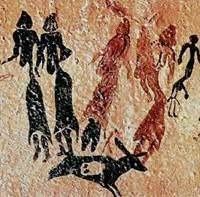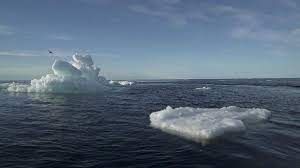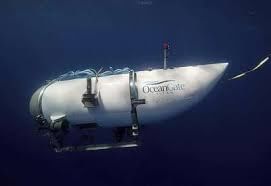UPSC Daily Current Affairs- 21st June 2023 | Current Affairs & Hindu Analysis: Daily, Weekly & Monthly PDF Download
GS-I
Mesolithic Rock painting

Why in News?
Recently, a Mesolithic period rock painting depicting a person tilling a piece of land has been found in Orvakallu village in Guntur district, Andhra Pradesh.
Key findings:
- The paintings were made with “natural white kaolin and red ochre pigments”,
- Ochre is a pigment composed of clay, sand, and ferric oxide.
- Kaolinite is a soft, earthy, and usually white mineral produced by the chemical weathering of aluminum silicate minerals like feldspar.
- These paintings throw light on aspects of the social life and culture of the people who lived in the area.
- One of the paintings depicted a man catching a wild goat with his left hand while wielding a hook-like implement to control it.
- Another showed two couples standing with their hands raised while a child stood behind them.
What is the Mesolithic period?
- It is also called Middle Stone Age which existed between the Paleolithic (Old Stone Age) and the Neolithic (New Stone Age).
- Timeframe: This period is generally considered to have occurred between approximately 12,000-10,000 years ago
- Lifestyle: During the Mesolithic period, human societies were predominantly hunter-gatherer communities.
- People relied on hunting, fishing, and gathering wild plant resources for their sustenance.
- Stone tools found during this period are generally tiny, and are called microliths.
- Microliths were probably stuck onto handles of bone or wood to make tools such as saws and sickles.
- At the same time, older varieties of tools continued to be in use.
Source: The Hindu
Blue Ocean Event: Arctic Ocean to be Ice-Free by 2030s

Why in News?
A new study published in Nature Communications warns that the Arctic Ocean could be ice-free in summer by the 2030s, even with significant emission reduction efforts.
- This alarming conclusion challenges previous predictions and highlights the global, damaging, and dangerous consequences of such a scenario.
Accelerated Climate Heating in the Arctic
- Fastest Heating: The Arctic region has been experiencing climate heating at a faster rate than any other part of the planet, making it a frontline area for climate change.
- Focus on Sea Ice: Scientists and local indigenous communities closely monitor the sea ice that covers much of the Arctic Ocean during winter, as it is a critical indicator of climate change.
- Diminishing Sea Ice: Over the past 40 years, multiyear sea ice, which remains at the end of summer, has reduced from approximately 7 million sq. km to 4 million sq. km, representing a significant loss.
Predicting an Ice-Free Arctic: Blue Ocean Event
- What is it: Scientists have been studying when the Arctic Ocean might become ice-free in summer, known as a “blue ocean event,” defined by the sea ice area dropping below 1 million sq. km.
- Complex Modeling: Sea ice is challenging to model accurately due to its sensitivity to atmospheric and oceanic circulation and heat transfer. Previous climate models underestimated the loss of sea ice compared to actual observations.
- Observationally Constrained Projections: The latest study takes a calibrated approach, using observational data to refine the models and project sea ice decline. It suggests the Arctic could become ice-free in summer as early as the 2030s, even with emission reductions.
Implications of an Ice-Free Arctic:
- Climate Feedback: The loss of Arctic sea ice amplifies warming through positive feedback, as it reduces sunlight absorption by the ocean, potentially accelerating the melting of the Greenland ice sheet and contributing to sea-level rise.
- Environmental Shifts: An ice-free Arctic would lead to changes in atmospheric circulation, storm tracks, and ocean biological activity, with far-reaching and undesirable consequences.
- Slender Benefits: While there may be some perceived benefits, such as shorter shipping routes, they pale in comparison to the negative impacts on the climate system and global ecosystems.
- A new study published in Nature Communications warns that the Arctic Ocean could be ice-free in summer by the 2030s, even with significant emission reduction efforts.
- This alarming conclusion challenges previous predictions and highlights the global, damaging, and dangerous consequences of such a scenario.
Accelerated Climate Heating in the Arctic
- Fastest Heating: The Arctic region has been experiencing climate heating at a faster rate than any other part of the planet, making it a frontline area for climate change.
- Focus on Sea Ice: Scientists and local indigenous communities closely monitor the sea ice that covers much of the Arctic Ocean during winter, as it is a critical indicator of climate change.
- Diminishing Sea Ice: Over the past 40 years, multiyear sea ice, which remains at the end of summer, has reduced from approximately 7 million sq. km to 4 million sq. km, representing a significant loss.
Predicting an Ice-Free Arctic: Blue Ocean Event
- What is it: Scientists have been studying when the Arctic Ocean might become ice-free in summer, known as a “blue ocean event,” defined by the sea ice area dropping below 1 million sq. km.
- Complex Modeling: Sea ice is challenging to model accurately due to its sensitivity to atmospheric and oceanic circulation and heat transfer. Previous climate models underestimated the loss of sea ice compared to actual observations.
- Observationally Constrained Projections: The latest study takes a calibrated approach, using observational data to refine the models and project sea ice decline. It suggests the Arctic could become ice-free in summer as early as the 2030s, even with emission reductions.
Implications of an Ice-Free Arctic:
- Climate Feedback: The loss of Arctic sea ice amplifies warming through positive feedback, as it reduces sunlight absorption by the ocean, potentially accelerating the melting of the Greenland ice sheet and contributing to sea-level rise.
- Environmental Shifts: An ice-free Arctic would lead to changes in atmospheric circulation, storm tracks, and ocean biological activity, with far-reaching and undesirable consequences.
- Slender Benefits: While there may be some perceived benefits, such as shorter shipping routes, they pale in comparison to the negative impacts on the climate system and global ecosystems.
Conclusion
- The potential ice-free Arctic Ocean by the 2030s, as indicated by the study, underscores the urgent need for climate action.
- The consequences of such a scenario extend far beyond.
- The study highlights the imperative of mitigating climate change to avoid further damage to the Arctic and the planet as a whole.
- The potential ice-free Arctic Ocean by the 2030s, as indicated by the study, underscores the urgent need for climate action.
- The consequences of such a scenario extend far beyond.
- The study highlights the imperative of mitigating climate change to avoid further damage to the Arctic and the planet as a whole.
Source: The Hindu
GS-II
Asia Pacific Plant Protection Commission
Why in News?
The Asia Pacific Plant Protection Commission unanimously elected India as chair of the Standing Committee on Integrated Pest Management (IPM) for the biennium 2023-24 during the 32nd Session held in Bangkok.
About Asia Pacific Plant Protection Commission:
- It is an intergovernmental organization that promotes cooperation among countries in the Asia-Pacific region to enhance plant health and plant protection.
- It was established in 1956 as a regional body approved by the Food and Agriculture Organization (FAO) of the United Nations.
- Member Countries: The commission consists of 25 member countries, including India.
- Structure of the organization:
- The Commission consists of representatives of all member countries and elects amongst them a Chairperson who serves for a period of two years.
- The Director-General of the Food and Agriculture Organization appoints and provides the secretariat that coordinates, organizes and follows up the work of the Commission.
- The Commission, according to its provisions convenes at least once every two years and opens for participation to all member countries.
- Objectives: The commission coordinates and supports plant protection activities of its Members in Asia and the Pacific, with emphasis on developing regional standards for phytosanitary measures (RSPMs) etc.
Source: PIB
One Health Approach: EU’s action to combat antimicrobial resistance

Why in News?
Recently, the Council of the European Union (EU) adopted a set of recommendations to strengthen action against antimicrobial resistance (AMR).
About one health approach and Antimicrobial resistance (AMR):
- According to World Health Organization, ‘One Health’ is an approach to designing and implementing programmes, policies, legislation and research in which multiple sectors communicate and work together to achieve better public health outcomes.
- Antimicrobial Resistance (AMR) occurs when bacteria, viruses, fungi and parasites change over time and no longer respond to medicines making infections harder to treat and increasing the risk of disease spread, severe illness and death.
- Resistant microbes can pass between animals, plants and food and in the environment.
Emergence and spread of AMR:
- AMR occurs naturally over time, usually through genetic changes.
- Antimicrobial-resistant organisms are found in people, animals, food, plants and the environment (in water, soil and air).
- They can spread from person to person or between people and animals, including from food of animal origin.
- The main drivers include the misuse and overuse of antimicrobials, lack of access to clean water, sanitation and hygiene (WASH), poor infection and disease prevention and control in healthcare facilities and farms, poor access to quality, affordable medicines, vaccines and diagnostics etc.
Significance of One Health in context of rising zoonotic infections:
- Risk of disease: Human populations are growing and expanding into new geographic areas. As a result, more people live in close contact with wild and domestic animals, both livestock and pets.
- Climate change: The earth has experienced changes in climate and land use, such as deforestation and intensive farming practices.
- Disruptions in environmental conditions and habitats can provide new opportunities for diseases to pass to animals.
- Global movement: The movement of people, animals, and animal products has increased from international travel and trade.
- As a result, diseases can spread quickly across borders and around the globe.
- Collaborative effort: Many of the same microbes infect animals and humans, as they share the ecosystems, they live in.
- For instance, rabies in humans is effectively prevented only by targeting the animal source of the virus (for example, by vaccinating dogs).
- Combating disease threat: The areas of work in which a One Health approach is particularly relevant include food safety, the control of zoonosis (diseases that can spread between animals and humans, such as flu, rabies and Rift Valley Fever) and combating antibiotic resistance.
- Information on viral agents: Information on viruses circulating in animals is crucial to the selection of viruses for human vaccines for potential influenza pandemics.
- Well-coordinated approach: Drug-resistant microbes can be transmitted between animals and humans through direct contact between animals and humans or through contaminated food, so to effectively contain it, a well-coordinated approach in humans and in animals is required.
EU’s action to combat antimicrobial resistance:
Combating AMR in a One Health approach:
- The commission submitted the proposal for a recommendation on stepping up EU actions to combat AMR in a One Health approach.
- These recommendations were part of a proposal submitted by the European Commission to the European Council.
Focussing on the health of humans, animals and the environment:
- It recommended the prudent use of antimicrobials such as antibiotics in human and animal health for reducing the risk of microorganisms becoming resistant to medical intervention.
The proposal included a series of actions to:
- Strengthen national action plans against antimicrobial resistance.
- Reinforce surveillance and monitoring of AMR and antimicrobial consumption (AMC).
- Strengthen infection prevention and control as well as antimicrobial stewardship and prudent use of antimicrobials.
- Recommend targets for AMC and AMR in human health.
The target:
Surveillance and monitoring:
- The targets called for closing existing surveillance and monitoring gaps and ensuring the completeness of data, including real-time information.
- It also includes timely access to data on both AMR and AMC at all levels, like the community, hospitals and long-term care facilities.
Reducing the consumption of antibiotics:
- Reducing the total consumption of antibiotics in humans by 20 percent in the Union compared with the baseline year of 2019 is also another target.
- This would be applicable for the community and hospital sectors combined, including in long-term care facilities and in home-care settings.
AWaRe classification of WHO:
- The member states must also ensure that at least 65 percent of the total consumption of antibiotics in humans belongs to the access group of antibiotics as defined in the AWaRe classification of the World Health Organization.
Measures Taken to Rising Anti-Microbial Resistance in India:
- National programme on AMR containment: It was launched during the 12th FYP in 2012-17
- National Action Plan on Antimicrobial Resistance (NAP-AMR): It has a focus on the One Health approach and was launched on 19th April 2017 with the aim of involving various stakeholders ministries/departments.
- AMR Surveillance Network: ICMR has established the AMR surveillance and research network (AMRSN) in 2013, to generate evidence and capture trends and patterns of drug resistant infections in the country.
- AMR Research and International Collaboration: ICMR has taken initiatives to develop new drugs /medicines through international collaborations in order to strengthen medical research in AMR.
- India’s National Action Plan for containment of AMR: It focuses on an integrated One Health approach and involves coordination at the state, national and international levels.
Way Forward:
Therefore successful public health interventions require the cooperation of human, animal, and environmental health partners. Professionals in human health, animal health, environment and other areas of expertise need to communicate, collaborate on, and coordinate activities. By promoting collaboration across all sectors, a One Health approach can achieve the best health outcomes for people, animals, and plants in a shared environment.
Source: DTE
GS-III
Submersible vs submarine: Tourist submersible missing

Why in News?
The Titan, the vessel that went missing in the area of the Titanic wreck in the North Atlantic, is classified as a submersible, not a submarine.
- Numerous complications - weather conditions, the lack of light at night, the state of the sea and water temperature, depth (14000 feet) - could hinder the effort to rescue the five people aboard the deep-diving submersible.
What are Submersibles?
- Submersibles are small, limited range watercrafts designed for a set mission, that are built with characteristics that allow them to operate in a specific environment
- These vessels are typically able to be fully submerged into water and cruise using their own power supply and air renewal system.
- While some submersibles are remotely-operated and essentially manually controlled or programmed robots, these usually operate unmanned.
- Vessels like the missing Titan are known as human-occupied vehicles.
The Titan:
- It was designed to transport five people to depths of around 4,000m in order to reach the Titanic shipwreck, which lies approximately 370 miles south of Newfoundland, Canada.
- Made of titanium and carbon fiber, it weighs around 10,432 kgs and can also take on speeds of about 3 knots/5.5 km per hour.
- It doesn’t have a lot of propulsion so it can’t sail great distances but it has just enough propulsion to sail and operate in and around the wreck and then come back to the surface.
- Experts believe that the Titan likely lost power or communication with its mother ship, the Polar Prince.
- In this case, the Titan's safety mechanism would activate, causing the ship to release the weight that it had been using to descend to the shipwreck.
How are Submersibles different from Submarines?
- The primary difference between a submersible and a submarine is that the former is launched from a mother vessel, or home vessel.
- Submersibles are typically launched on a raft or platform which is placed into water and ultimately descends down via four electric thrusters which help it to reach speeds of 3 knots.
- When it returns to the surface, it must be loaded back onto the surface platform.
- Submersibles don't have things like typically large propulsion systems, they don't have ballast systems. They also have limited power reserves.
- Unlike submarines, submersibles also have a viewport and external cameras to view the outside space surrounding the vessel.
Source: Indian Express
TRAI suggests norms for Undersea Cables

Why in News?
The Telecom Regulatory Authority of India (TRAI) has issued recommendations on rules governing undersea cables connecting Indian telecom networks to the global internet.
- These recommendations address concerns raised by the Department of Telecommunications (DoT) regarding the participation of Indian firms in undersea cable projects and related regulatory clearances.
What are Undersea Cables?
- Undersea cables, also known as submarine cables, are fiber optic strands enclosed in protective layers laid on the ocean floor.
- They are essential for global connectivity, transmitting data and communication signals between continents and nations.
- These cables form the backbone of international communications infrastructure, ensuring reliable internet connectivity and supporting seamless communication worldwide.
- They play a pivotal role in facilitating collaboration, trade, and socio-cultural interactions on a global scale.
Key Recommendation by TRAI
(A) Ownership Requirements for Undersea Cables:
- Proof of Ownership: TRAI recommends that all Indian telecom companies operating undersea cables must demonstrate ownership of the portion of cables located in Indian waters.
- Significance: This requirement ensures that Indian firms have a stake in undersea cable infrastructure and fosters their active participation in global connectivity.
(B) Distinction between Cable Landing Stations and Points of Presence (PoPs):
- Differentiation of Facilities: TRAI suggests distinguishing between cable landing stations and PoPs, which are further connected to the stations.
- Regulatory Simplification: Owners of PoPs would be exempted from multiple clearance requirements but would need to comply with lawful interception regulations.
- Significance: This differentiation streamlines the regulatory process for telecom companies and promotes ease of doing business.
(C) Allowance for Dark Fiber and Stubs:
- Dark Fiber Usage: TRAI recommends permitting the use of dark fiber (unused optical fiber) on existing cable landing stations.
- Use of Stubs: TRAI suggests allowing the installation of stubs, short cables in Indian waters, for potential future expansion and use.
- Significance: Allowing dark fiber usage and stub installations enhances the flexibility and scalability of undersea cable infrastructure in India.
(D) Financial Viability Models for Repair Vessels
- Commissioning Indian Flagged Ships: TRAI proposes that a government committee explore financial viability models for commissioning Indian flagged ships for the repair and maintenance of undersea cables.
- Significance: This promotes indigenous capabilities and supports the growth of the domestic maritime industry.
(E) Domestic Traffic and Terrestrial Networks
- Permission for Domestic Traffic: TRAI recommends explicitly permitting the carrying of domestic traffic on undersea cables, allowing for connectivity between domestic locations.
- Extension through Terrestrial Networks: The regulator suggests enabling undersea cable systems to extend further inland through terrestrial networks to facilitate the flow of international traffic.
- Significance: This improves efficiency and promotes seamless communication within India.
Critical Information Infrastructure Protection
- Notification of Critical Infrastructure: TRAI proposes notifying undersea cables as critical information infrastructure, making them eligible for protection by the National Critical Information Infrastructure Protection Centre (NCIIPC).
- Significance: Recognizing undersea cables as critical infrastructure strengthens their security and safeguards against potential cyber threats.
India’s Cable Projects and Future Expansion
- India-Asia Xpress (IAX) and India-Europe Xpress (IEX): Reliance Jio is leading these projects, connecting India to Singapore, the Persian Gulf, and Europe. The capacity is around 200 Tbps, with funding from a consortium including Facebook and Google.
- MIST: This cable will link Mumbai and Cochin in India to Myanmar, Thailand, Malaysia, and Singapore. It has a capacity of 218 Tbps and is scheduled for operation in 2024.
- Blue-Raman: Connecting Italy, Greece, Israel, Jordan, Saudi Arabia, Oman, and India, this cable bypasses the Egyptian chokepoint. It has a capacity of over 200 Tbps and is funded by a consortium led by Google.
- SEA-ME-WE 6: Upgrading the link from Singapore to Marseille, this cable spans 19,200 km with a capacity of 126 Tbps. It is scheduled to be operational in 2025 and involves a consortium of telecommunications companies.
- 2 Africa Pearl: Extending from India and Pakistan, this cable orbits Africa, connecting 33 nations across three continents. It has a capacity of 180 Tbps and is funded by a consortium that includes Facebook and China Mobile.
India’s Significance in Undersea Connectivity
- Growing digital economy: India’s rapidly expanding digital market and high data usage make it a significant consumer and provider of global data connectivity.
- Strategic location: Situated at the crossroads of major regions, India serves as a vital link connecting Asia, Europe, Africa, and the Middle East through undersea cable networks.
- Technical expertise: India boasts a large pool of skilled professionals in the tech industry, enabling it to actively participate in the development, deployment, and maintenance of undersea cables.
- Rising global influence: With its projected economic growth, population size, and geopolitical significance, India’s increasing influence positions it as a key player in shaping the future of undersea cable connectivity.
- Connectivity expansion: India’s efforts to enhance domestic and international connectivity, coupled with its focus on improving infrastructure and regulatory frameworks, contribute to its importance in undersea cable networks.
Conclusion
- TRAI’s recommendations on undersea cables aim to enhance the participation of Indian firms, simplify regulatory processes, and strengthen the security and efficiency of undersea cable infrastructure in India.
- These recommendations promote the growth of the telecom industry and support the country’s digital connectivity goals.
Source: The Hindu
GEMCOVAC –OM Vaccine

Why in News?
Recently, India’s first indigenous mRNA vaccine for the Omicron variant, GEMCOVAC-OM was approved under emergency use guidelines by the Drug Controller General of India.
About GEMCOVAC –OM Vaccine:
- It was developed using the indigenous platform technology by Gennova Biopharmaceuticals Ltd. and supported under the Mission COVID Suraksha, implemented by Biotechnology Industry Research Assistance Council (BIRAC).
- It is a thermo-stable vaccine, which does not require ultra-cold chain infrastructure used for other approved mRNA-based vaccines, making it easy for deployment pan India.
- It is delivered intra-dermally using a needle-free injection device system.
- When administered intradermally in participants as a booster, it generated significantly higher immune responses.
- The clinical outcome demonstrates the need for variant-specific vaccines for desired immune response.
Key facts about BIRAC
- It is a not-for-profit Section 8, Schedule B, Public Sector Enterprise, set up by the Department of Biotechnology (DBT), Government of India,
- It is an Interface Agency to strengthen and empower emerging Biotech enterprises to undertake strategic research and innovation, addressing nationally relevant product development needs.
What is mRNA vaccine?
- It contains messenger RNA (mRNA), a single-stranded RNA molecule that complements DNA.
- It is created in the nucleus when DNA is transcribed by RNA polymerase to create pre-mRNA.
Source: The Hindu
|
63 videos|5408 docs|1146 tests
|






















